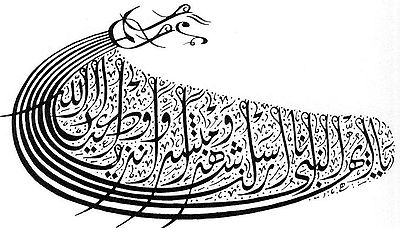

Part of a serieson

Diwani is a calligraphic variety of Arabic script, a cursive style developed during the reign of the early Ottoman Turks (16th century - early 17th century). It reached its height of popularity under Süleyman I the Magnificent (1520–1566).
It was labeled the Diwani script because it was used in the Ottoman diwan and was one of the secrets of the sultan's palace. The rules of this script were not known to everyone, but confined to its masters and a few bright students. It was used in the writing of all royal decrees, endowments, and resolutions. A Diwani text adorned with a tugrah, a complex calligraphic seal, represented the authority of the Sultan and the Ottoman state.[1]
The Diwani script can be divided into two types:


Diwani is marked by beauty and harmony, and accurate small samples are considered more beautiful than larger ones. It is still used in the correspondence of kings, princes, presidents, and in ceremonies and greeting cards, and has a high artistic value.
Overviews
Letters
Literary
Modern
spoken
Nile Valley
North (Qeltu)
Others
Academic
Linguistics
Technical
Other
Styles
Others
Objects
Calligraphers
Organizations
Influences
Part of Islamic arts